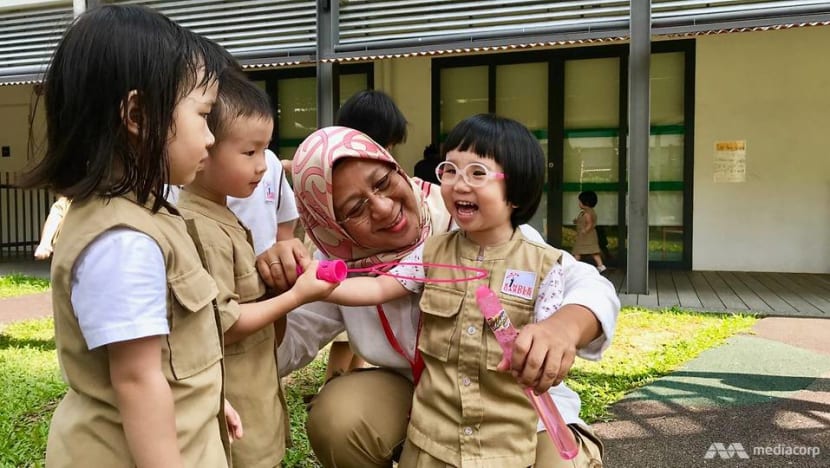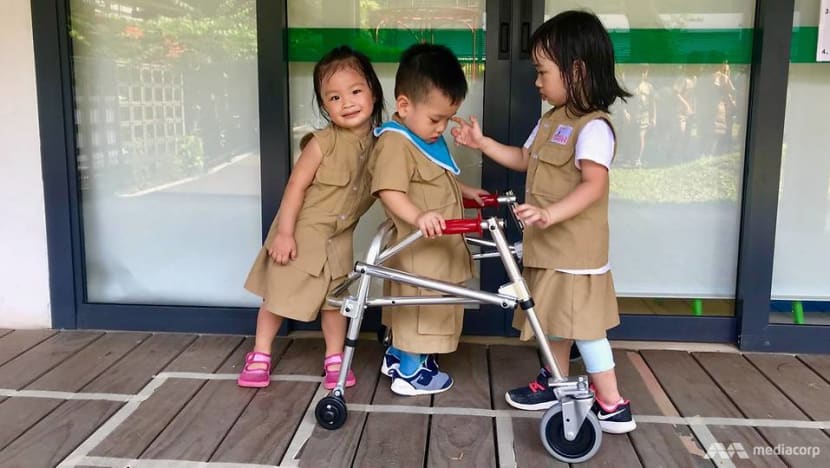Little tweaks, with a big difference: The value proposition of inclusive preschools
A growing number of preschools in Singapore are beginning to offer an "inclusive model", where children with special needs are fully integrated with their typically developing peers. But does this model really work, and what are the benefits?

Children playing during outdoor break time at Kindle Garden, Singapore's first inclusive preschools. (Photo: Lianne Chia)
SINGAPORE: It was a scene that you would associate with any preschool in Singapore - sounds of exuberant children echoing through the playground as they enjoyed the swings and slides during their outdoor play session.
Dressed in their identical khaki uniforms, it was almost impossible to tell the children apart.
But there are little differences when you look closely at the playground and how the preschool is laid out.
A life-size model of a toy car is specially designed to allow a child in a wheelchair to enter and pretend to be a driver. Tactile lines laid out on the floor of the open-concept schoolhouse give a child with visual impairment extra help to find the classroom or bathroom. And the treehouse in the playground provides the space and accessibility for a child in a wheelchair to move around freely.
This is Kindle Garden, one of a growing number of preschools in Singapore that offer a space where all children – with or without special needs – can learn and play together.
HOW DOES THE MODEL WORK?
Broadly speaking, inclusion in a school setting simply means that the school is willing to support children with disabilities and additional needs, Associate Professor Sirene Lim, the academic lead from the Singapore University of Social Sciences’ (SUSS) Early Childhood Education Programme, said.
She noted that in some models, children with disabilities may be placed physically on the same campus as regular, typically developing children.

But preschools in Singapore that follow an inclusive model go beyond this.
In the case of Kindle Garden, the first inclusive preschool to be set up here, empowering all children and giving them the support they need to take part in the various activities is key. The preschool, which is run by non-profit AWWA, caters to children of all abilities, and about 30 per cent of the 80 or so children currently enrolled have special needs such as autism, Down Syndrome or cerebral palsy.
“We want them to have equal opportunities, to be a part of the activities, the environment and everything that we do,” said Honey Ng, Kindle Garden’s assistant director of preschool support.
“The equipment and design of this place will give them the sense that therapy can happen anywhere, and they don’t need to be pulled out,” she added. For example, a child with additional oral-motor needs can get additional help during mealtimes, with support staff like a speech and language therapist working with all the children in a group.
“They may all be eating, and the teacher might tell them to chew in a particular way,” she said. “And all the children will get into this game, but it’s actually therapy for those children who need it.”
New entrant SAIL Playhouse focuses on differentiating the lesson for each child, depending on their needs. The preschool, which opened in August, has seven children, three of whom have additional needs.
“They actually all go through the same lesson, but we adapt our instructions, so that when I give instructions to different children, it’s different, and I expect different outcomes,” said SAIL Playhouse’s centre director Chua Pei Lin.
In a pizza-making activity, for example, some children who might have difficulty with their fine motor skills might receive materials which have already been cut up for them, while their peers would be instructed to cut their own materials and count the number that they need.
“I have different expectations for different children, but they’re all participating at a level they are able to,” she said.
Ms Chua admitted that with children of different abilities and needs all integrated into one class, lessons can get disrupted at times. But apart from giving teachers mentoring and support, SAIL Playhouse also has an in-house early interventionist who provides the teachers with extra support in the classroom.
“Sometimes if we get a child who might need more support, we get the interventionist to work with the child to establish a routine, then slowly integrate him or her back into class,” she said.
FILLING A GAP
Such inclusive preschools hope to fill a gap in Singapore’s early childhood landscape, particularly for children with special needs.
Currently, children with mild developmental or learning needs can receive intervention that is based in their preschools through the Development Support or Learning Support programme, where therapists and Learning Support Educators provide targeted short-term intervention in selected preschools for these children.
Children with moderate to severe developmental needs can be enrolled in Early Intervention Programme for Infants and Children (EIPIC) centres where they receive more intensive intervention. There has been an increase in the number of children referred to EIPIC centres, from an average of 1,200 referrals annually from 2012-2014, to an average of 1,600 annually from 2015-2017, the Ministry of Social and Family Development (MSF) told Channel NewsAsia.

While MSF noted that the “majority of children” who are enrolled in an EIPIC centre are also enrolled in preschools, Kindle Garden’s Dr Ng said it can be a challenge for parents who need to ferry their children around to the different centres.
“We saw them rushing to bring them to one school, and later to another, and if they have siblings, it’s multiple trips for them,” she said. “So we saw this gap that needed to be filled.”
Parents such as Eliza Chan also struggled to find a preschool for her daughter, Khloe, who has Down Syndrome. She had hoped that Khloe, who was already enrolled in early intervention, could gain exposure to a bigger social setting, and meet other typically developing children.
“I emailed three to four preschools to ask if they accept children of her kind, but they turned me down quite flatly,” she said.
“Maybe they felt they couldn’t care for the child, but it was very frustrating.”
Khloe has been attending Kindle Garden for about two years, and Ms Chan could not be happier with her progress.
“She has learnt quite a lot, and the teachers don’t stereotype her,” she said. “They treat her just like any other child.”
EVERYONE BENEFITS – NOT JUST CHILDREN WITH SPECIAL NEEDS
But the benefits of the inclusive preschool model are not merely limited to children with special needs.
“Being able to understand another person’s point of view and another person’s feelings is very crucial to early education,” said SUSS’s Prof Lim. “And we can’t do that unless children are put in diverse groups, where they face differences and play together with their friends.”
SAIL Playhouse’s Ms Chua noted that the typically-developing children in her preschool are showing “a lot more social sensitivity”, even in the short span of time that the preschool has been open.
“They notice that everyone is learning at a different pace, so they learn that there is nothing wrong to need a bit more help in certain areas,” she said.
“Even in our toddler age group, where we have a child who is still learning to walk, I can see our toddler children cheering the child on, going to the child and patting the child on the back,” she added. “So you see all this compassion and kindness even at this age group...what more when they get older?”
This is something that parents like Tessa Lam, who enrolled her 20-month-old twin daughters at Kindle Garden in August, can also see.
“I’ve noticed that sometimes when they see each other crying or feeling unhappy, they will run and comfort each other,” she said. “I read that at 20 months, the children are usually very self-centred. But it’s so different ... there’s this caring attitude, and I attribute that to the environment here.”

WHAT NEXT?
More than two years have passed since Kindle Garden opened. And while Kindle Garden’s Dr Ng admitted that there was some “initial worry” about whether parents of typically-developing children would enrol their children in the preschool, its popularity has now been established.
Today, the preschool is running at full capacity. Parents of another 80 children have expressed interest in enrolling their child in the school.
The model is also gaining traction, with the opening of other similar inclusive preschools run by private operators – such as SAIL Playhouse – in recent months. Bright Path, an inclusive preschool by the Busy Bees Group, officially opened in July and, as of August, had an enrolment of four children.
And at a national level, MSF had announced in its 2017 Committee of Supply Debate that it was studying the feasibility of rolling out an inclusive preschool model that enables children with special needs to study alongside their typically developing peers.
In response to Channel NewsAsia’s queries, MSF said it welcomes the “several ongoing efforts” in the sector to develop preschools that cater to children with special needs.
“We will also study the experience of these centres as we consider what is the most sustainable and suitable model of inclusive preschool for our context.”
In parallel, MSF added that it plans to increase support for children with special needs within the mainstream setting. “One programme that is being explored is an enhanced Development Support programme, which will allow children who have made sufficient progress in an EIPIC centre to continue to receive support within their preschool.”
SUSS’ Prof Lim noted that the increasing trend of such inclusive preschools is a positive step for Singapore. But moving forward, she reiterated the importance of training special education teachers, as well as the need to support them in the classroom with early interventionists or therapists.
“The philosophy towards educating young children should always be inclusive, but teachers must know where to get support, giving them a bigger toolkit to draw from in terms of teaching strategies, and how to observe children better to cater to their needs,” she said.
“Teachers also need to work with therapists in order to understand what the children’s needs are, and to be supported by specialists in order to provide extra help for these children, whether it’s speech therapy or sensory integration.”
In the meantime, inclusive preschools like Kindle Garden and SAIL Playhouse hope to blaze a trail for others to follow.
Kindle Garden, said Dr Ng, is beginning to run expert series and workshops to encourage others in the sector to work with children with special needs.
And as for SAIL Playhouse’s Ms Chua, she hopes that the model she uses will inspire others to also venture into the sector.
“In general, I think there’s a lot of hesitation when it comes to inclusion, so we wanted to show that you don’t have to be really big, or have access to a lot of resources, to be able to do it well,” she said.
“When the parents and children come into our school, they realise that it doesn’t actually look very much different from a typical preschool. So that’s the message we want to send,” she added.
“Little, small efforts can really help make the programme a lot more inclusive, and make a big difference.”














